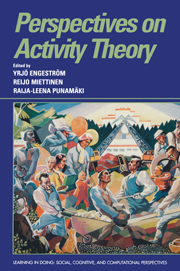Book contents
- Frontmatter
- Contents
- List of contributors
- Series foreword
- Introduction
- Part I Theoretical issues
- Part II Language and its acquisition
- Part III Play, learning, and instruction
- Part IV Technology and work
- 21 The theory of activity changed by information technology
- 22 Activity theory, transformation of work, and information systems design
- 23 Innovative learning in work teams: Analyzing cycles of knowledge creation in practice
- Part V Therapy and addiction
- Author index
- Subject index
23 - Innovative learning in work teams: Analyzing cycles of knowledge creation in practice
Published online by Cambridge University Press: 05 June 2012
- Frontmatter
- Contents
- List of contributors
- Series foreword
- Introduction
- Part I Theoretical issues
- Part II Language and its acquisition
- Part III Play, learning, and instruction
- Part IV Technology and work
- 21 The theory of activity changed by information technology
- 22 Activity theory, transformation of work, and information systems design
- 23 Innovative learning in work teams: Analyzing cycles of knowledge creation in practice
- Part V Therapy and addiction
- Author index
- Subject index
Summary
Introduction
Innovative organizational learning is collaborative learning in work organizations that produces new solutions, procedures, or systemic transformations in organizational practices (Engeström, 1995). Studies of innovative organizational learning have thus far produced relatively general conceptual tools (e.g., Argyris & Schön, 1978; Senge, 1990). Although it is commonly acknowledged that innovative learning at work has a complex cyclic character (e.g., Dixon, 1994), there have been few detailed attempts to theorize about such cycles and to model their steps as they occur in learning processes in work teams.
One of the most interesting attempts is the recent book by Nonaka and Takeuchi (1995). These authors focus exclusively on innovative learning, which they prefer to call knowledge creation in organizations. Nonaka and Takeuchi propose a theory of knowledge on which they build a model of cycles of knowledge production. Their examples are drawn primarily from practices and cases of new product development in Japanese companies.
In my research projects on work teams in American and Finnish organizations, we have identified and analyzed a number of innovative learning processes within and between teams (for recent examples, see Engeström, 1994a, 1995; Engeström, Engeström, & Kärkkäinen, 1995). We typically videotape series of team meetings and interactions at work and analyze transcripts of these interactions as our prime data. This approach enables us to conduct very detailed data-driven analyses of the discursive processes, practical actions, and mediating artifacts that are employed in the step-by-step production of an innovative solution or idea.
- Type
- Chapter
- Information
- Perspectives on Activity Theory , pp. 377 - 404Publisher: Cambridge University PressPrint publication year: 1999
- 385
- Cited by



